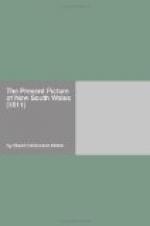Buildings.
The buildings are of stone, brick, and lath and plaister; weather-boarded; and the houses are durable. There are two churches; one, St. Philip’s, which possesses a very handsome service of communion plate, presented by his Majesty, and received by the Calcutta, on the 8th of October, 1803; and the other, St. John’s, at Parramatta: There are likewise a school and chapel at Hawkesbury, where divine service is performed. Two jails have also been erected in the colony. A house has been built for the governor at each of the principal settlements; which also possess several very commodious barracks, with many other public buildings, and a great number of extensive and handsome houses, the property of private individuals. There are a stone bridge, and several very substantial wooden ones, which, if not celebrated for beauty, are found extremely serviceable, and well calculated for all the present purposes of the colony, which is not yet sufficiently advanced in prosperity to prefer ornament to use. A new stone citadel is in a course of building, on which the Royal Standard, for the first time in these settlements, was hoisted on the 4th of June, 1803; and several batteries are erected.—For a more particular account of the buildings at Sydney, I must refer the reader to the following explanation of the Views of Sydney, the principal seat of government, which accompany this sketch:—
In the View of Sydney, from the East side of the Cove, No. I. the house under two birds, as r r, is the Residence of the Governor in Chief, which is built of brick, plaistered over; has very convenient stables and outhouses, and is a very pleasant and comfortable residence; the garden and shrubbery extend to about four acres. The Flag-staff near the gardenhouse bears the Union on holidays, and different signal-colours are used there to form a communication between the shore and the king’s vessels in the Cove. The Pine tree growing in the garden is from Norfolk Island, and runs to an amazing height and thickness; the knots from this tree are used instead of flambeaux, and burn remarkably well. The buildings under three birds, as r r r, extending some distance right and left, and forming a square, are the Military Barracks, built of brick, the largest of which was erected by Lieutenant-Governor Foveaux: This is an extensive well-built place, and was finished in far less time than any building ever begun upon by government in




